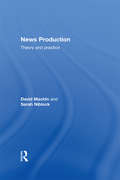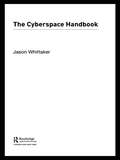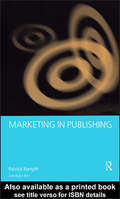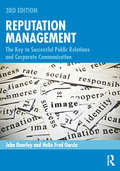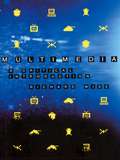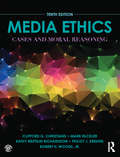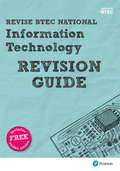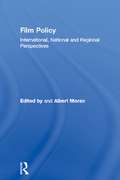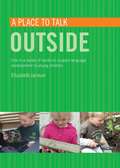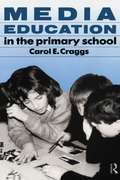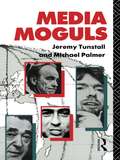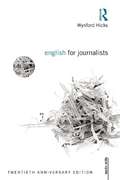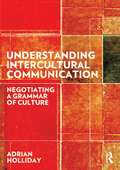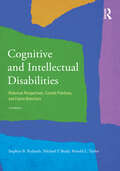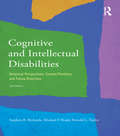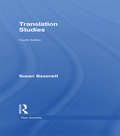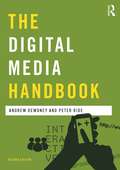- Table View
- List View
News Production: Theory and Practice
by Sarah Niblock David MachinBringing to the forefront a much-needed book that bridges the gap between journalistic theory and practice, Sarah Niblock and David Machin provide here an invaluable real-life account of reporting in the context of contemporary newsrooms. Providing eight detailed ethnographies of eight different news production settings, News Production includes individual chapters that follow two news workers through their daily routines, detailing the exact nature of their jobs. It provides students with: case studies to compare to their own experiences concrete examples to consolidate their skill-based training questions to raise about their placements information on how to prepare reports constraints they may encounter, and how to deal with them. With chapters including ‘News Agencies’, ‘The Roving Reporter’, ‘Photojournalism’ and ‘The New Reporter Learning the Ropes’, for anyone taking practical units in news reporting, sub-editing, and law and ethics, News Production will provide them with all the information they need to succeed in this hectic, competitive and exciting world.
News Production: Theory and Practice
by Sarah Niblock David MachinBringing to the forefront a much-needed book that bridges the gap between journalistic theory and practice, Sarah Niblock and David Machin provide here an invaluable real-life account of reporting in the context of contemporary newsrooms. Providing eight detailed ethnographies of eight different news production settings, News Production includes individual chapters that follow two news workers through their daily routines, detailing the exact nature of their jobs. It provides students with: case studies to compare to their own experiences concrete examples to consolidate their skill-based training questions to raise about their placements information on how to prepare reports constraints they may encounter, and how to deal with them. With chapters including ‘News Agencies’, ‘The Roving Reporter’, ‘Photojournalism’ and ‘The New Reporter Learning the Ropes’, for anyone taking practical units in news reporting, sub-editing, and law and ethics, News Production will provide them with all the information they need to succeed in this hectic, competitive and exciting world.
The Cyberspace Handbook
by Jason WhittakerThe Cyberspace Handbook is a comprehensive guide to all aspects of new media, information technologies and the internet. It gives an overview of the economic, political, social and cultural contexts of cyberspace, and provides practical advice on using new technologies for research, communication and publication. The Cyberspace Handbook includes: *a glossary of over eighty key terms*a list of over ninety web resources for news and entertainment, new media and web development, education and reference, and internet and web information* specialist chapters on web design and journalism and writing on the web*Over thirty illustrations of internet material and software applications.Jason Whittaker explores how cyberspace has been constructed, how it is used and extends into areas as different as providing us immediate news or immersive games and virtual technologies for areas such as copyright and cybercrime, as well as key skills in employing the internet for research or writing and designing for the Web.
The Cyberspace Handbook
by Jason WhittakerThe Cyberspace Handbook is a comprehensive guide to all aspects of new media, information technologies and the internet. It gives an overview of the economic, political, social and cultural contexts of cyberspace, and provides practical advice on using new technologies for research, communication and publication. The Cyberspace Handbook includes: *a glossary of over eighty key terms*a list of over ninety web resources for news and entertainment, new media and web development, education and reference, and internet and web information* specialist chapters on web design and journalism and writing on the web*Over thirty illustrations of internet material and software applications.Jason Whittaker explores how cyberspace has been constructed, how it is used and extends into areas as different as providing us immediate news or immersive games and virtual technologies for areas such as copyright and cybercrime, as well as key skills in employing the internet for research or writing and designing for the Web.
Marketing in Publishing
by Robin Birn Patrick ForsythMarketing in Publishing, offers a wealth of practical information on creative strategies to increase book sales in a competitive and rapidly-changing marketplace. It is the first comprehensive study in this area to be published since the ending of the Net Book Agreement.Patrick Forsyth, now a marketing consultant, draws in his many years' experience of the publishing industry to reinstate marketing firmly where it should be: as an integral and integrated part of the whole marketing process.Marketing in Publishing gives expert guidance on different elements of the marketing process, including advice on promotional and direct mail options, and a step-by-step section on how to make an effective sales call. It includes a valuable discussion of fusing market research intelligently to identify new opportunities and market niches. The book also features an authoritative chapter evaluating the importance of electronic publishing.Completely up-to-date, Marketing in Publishing will be essential reading both for those working in marketing and editorial departments, and for students of publishing studies.
Reputation Management: The Key to Successful Public Relations and Corporate Communication
by John Doorley Helio Fred GarciaReputation Management is a how-to guide for students and professionals, as well as CEOs and other business leaders. It rests on the premise that reputation can be measured, monitored, and managed. Organized by corporate communication units including media relations, employee communication, government relations, and investor relations, the book provides a field-tested guide to corporate reputation problems such as leaked memos, unfair treatment by the press, and negative rumors, and focuses on practical solutions. Each chapter is fleshed out with the real-world experience of the authors and contributors, who come from a wide range of professional corporate communication backgrounds. Updates to the third edition include: Global content has been incorporated and expanded throughout the book, rather than being restricted to only one chapter. Opening vignettes, examples, and case studies have been updated in each chapter. Additional case studies and examples with an international focus have been added.
Reputation Management: The Key to Successful Public Relations and Corporate Communication
by John Doorley Helio Fred GarciaReputation Management is a how-to guide for students and professionals, as well as CEOs and other business leaders. It rests on the premise that reputation can be measured, monitored, and managed. Organized by corporate communication units including media relations, employee communication, government relations, and investor relations, the book provides a field-tested guide to corporate reputation problems such as leaked memos, unfair treatment by the press, and negative rumors, and focuses on practical solutions. Each chapter is fleshed out with the real-world experience of the authors and contributors, who come from a wide range of professional corporate communication backgrounds. Updates to the third edition include: Global content has been incorporated and expanded throughout the book, rather than being restricted to only one chapter. Opening vignettes, examples, and case studies have been updated in each chapter. Additional case studies and examples with an international focus have been added.
Multimedia: A Critical Introduction
by Richard WiseMultimedia: A Critical Introduction is a comprehensive guide to the new media form which has resulted from the application of computer technology to existing techniques of broadcasting and telecommunications transmission. The rapid growth of multimedia technologies such as the internet, e-mail and digital television holds the promise of a new 'information age' in which individual tastes are catered for, citizens become better informed, and new wealth is created. But are new media technologies really designed to achieve these utopian aims?Multimedia: a critical introduction provides a historical, cultural and political context to the development of multimedia, as both a technology and a concept. Individual chapters address:* the origins of multimedia in the unlikely interaction between the military and 1960s counter-culture: how the phenomenal US budgets allocated to US military research resulted in the microchip, and why the efforts of counter-culture computer hobbyists evolved into a multi-billion dollar industry.*the wider democratic and cultural implications of multimedia in the wake of the deregulation of the media industries by 'new right' governments in the 1980s, which has led to the domination of the media by transnational conglomerates.* issues of privacy and censorship in relation to new media, including discussion of cryptography, electronic surveillance, and attempts to regulate material such as pornography on the internet.* the use of digital technology to create special effects in feature films.
Multimedia: A Critical Introduction
by Richard WiseMultimedia: A Critical Introduction is a comprehensive guide to the new media form which has resulted from the application of computer technology to existing techniques of broadcasting and telecommunications transmission. The rapid growth of multimedia technologies such as the internet, e-mail and digital television holds the promise of a new 'information age' in which individual tastes are catered for, citizens become better informed, and new wealth is created. But are new media technologies really designed to achieve these utopian aims?Multimedia: a critical introduction provides a historical, cultural and political context to the development of multimedia, as both a technology and a concept. Individual chapters address:* the origins of multimedia in the unlikely interaction between the military and 1960s counter-culture: how the phenomenal US budgets allocated to US military research resulted in the microchip, and why the efforts of counter-culture computer hobbyists evolved into a multi-billion dollar industry.*the wider democratic and cultural implications of multimedia in the wake of the deregulation of the media industries by 'new right' governments in the 1980s, which has led to the domination of the media by transnational conglomerates.* issues of privacy and censorship in relation to new media, including discussion of cryptography, electronic surveillance, and attempts to regulate material such as pornography on the internet.* the use of digital technology to create special effects in feature films.
Media Ethics: Cases and Moral Reasoning
by Clifford G. Christians Mark Fackler Kathy Brittain Richardson Peggy Kreshel Robert H. WoodsMedia Ethics: Cases and Moral Reasoning challenges readers to think analytically about ethical situations in mass communication through original case studies and commentaries about real-life media experiences. This text provides a comprehensive introduction to the theoretical principles of ethical philosophies, facilitating ethical awareness. It introduces the Potter Box, with its four dimensions of moral analysis, to provide a framework for exploring the steps in moral reasoning and analyzing the cases. Focusing on a wide spectrum of ethical issues faced by media practitioners, the cases in this Tenth Edition include the most recent issues in journalism, broadcasting, advertising, public relations, and entertainment. Visit the companion website at http://www.mediaethicsbook.com/.
Revise BTEC National Information Technology Revision Guide (PDF)
by Alan Jarvis Daniel RichardsonOur revision resources are the smart choice for those revising for the externally assessed units in Information Technology BTEC Nationals from 2016. This book will help you to: • Revise all the essential content and key skills for each unit • Organise your revision with the one-topic-per-page format • Speed up your revision with helpful hints on how to tackle questions and tasks • Track your revision progress with at-a-glance check boxes • Check your understanding with annotated example responses • Practise with revision questions, with answers.
Film Policy: International, National and Regional Perspectives
by Albert MoranFilm Policy is the first comprehensive overview of the workings of the international film industry. The authors examine film cultures and film policy across the world, explaining why Hollywood cinema dominates the global film market, and the effects of the rise of television and video on the international industry. In a series of case studies drawn from North America, Europe, Latin America, Asia and Australia, the authors explore the relationship between Hollywood cinema product and national film cultures, and trace the development of international and national film policies, looking at issues of financing, regulation, protectionism and censorship.
Film Policy: International, National and Regional Perspectives
by Albert MoranFilm Policy is the first comprehensive overview of the workings of the international film industry. The authors examine film cultures and film policy across the world, explaining why Hollywood cinema dominates the global film market, and the effects of the rise of television and video on the international industry. In a series of case studies drawn from North America, Europe, Latin America, Asia and Australia, the authors explore the relationship between Hollywood cinema product and national film cultures, and trace the development of international and national film policies, looking at issues of financing, regulation, protectionism and censorship.
A Place To Talk Outside (PDF)
by Elizabeth JarmanThis series considers the significant role that the physical environment can play in supporting children's speaking and listening skills. The books provide guidance on assessing and improving environments for speaking and listening.
Media Education in the Primary School
by Carol CraggsMedia Education in the Primary School provides a clear, practical guide for teachers on how to approach media education. The author offers helpful advice on teaching about media institutions, news-gathering and on soaps, comics and advertising. Cross-cirucular classroom activities such as video-work, simulating advertising campaigns and photography are also included. All the activities have been thoroughly tested and are fully compatabile with current National Curriculum requirements.
Media Moguls
by Michael Palmer Jeremy TunstallThe emergence of a few powerful individuals in control of large sections of mass communication industries has coincided with world-wide media de-regulation. In the first book to take a close look at media moguls as a species, Jeremy Tunstall and Michael Palmer show how a handful of own-and-operate entrepreneurs run their empires with a highly eccentric and highly political management style. Individuals such as Berlusconi, Hersant, and Murdoch, in France, Germany, Italy, Britain and the US, are considered in the context of the changing European media industry. The book considers other, non-mogul trends: the emergence of a European media policy and a European-US-Japanese world media industry. Additional case studies focus on Reuters as a news-and-data super-agency and the part played by advertising and other media lobbies in shaping media policy.
English for Journalists: Twentieth Anniversary Edition
by Wynford HicksEnglish for Journalists has established itself as an invaluable guide to the basics of English in newsrooms the world over, focusing on the essential aspects of writing, from reporting speech to the house styles and jargon central to the language of journalism. Written in a highly accessible and engaging style, English for Journalists covers the fundamentals of grammar, spelling, punctuation and journalistic writing, with all points illustrated through a series of concise and illuminating examples. The book features practical, easy to follow rules, the correct and incorrect ways to report stories, and examples of common mistakes and problem words in journalistic writing. The twentieth anniversary edition adds a new introduction to the work from author Wynford Hicks, as well as updated examples throughout to improve accessibility, and a revised first chapter on the state of English today. This is an essential guide to written English for all practicing journalists and students of journalism today.
English for Journalists: Twentieth Anniversary Edition
by Wynford HicksEnglish for Journalists has established itself as an invaluable guide to the basics of English in newsrooms the world over, focusing on the essential aspects of writing, from reporting speech to the house styles and jargon central to the language of journalism. Written in a highly accessible and engaging style, English for Journalists covers the fundamentals of grammar, spelling, punctuation and journalistic writing, with all points illustrated through a series of concise and illuminating examples. The book features practical, easy to follow rules, the correct and incorrect ways to report stories, and examples of common mistakes and problem words in journalistic writing. The twentieth anniversary edition adds a new introduction to the work from author Wynford Hicks, as well as updated examples throughout to improve accessibility, and a revised first chapter on the state of English today. This is an essential guide to written English for all practicing journalists and students of journalism today.
Understanding Intercultural Communication: Negotiating a Grammar of Culture
by Adrian HollidayIn this book, Adrian Holliday provides a practical framework to help students analyse intercultural communication. Underpinned by a new grammar of culture developed by Holliday, this book will incorporate examples and activities to enable students and professionals to investigate culture on very new, entirely non-essentialist lines. This book will address key issues in intercultural communication including: the positive contribution of people from diverse cultural backgrounds the politics of Self and Other which promote negative stereotyping the basis for a bottom-up approach to globalization in which Periphery cultural realities can gain voice and ownership Written by a key researcher in the field, this book presents cutting edge research and a framework for analysis which will make it essential reading for upper undergraduate and postgraduate students studying intercultural communication and professionals in the field.
Understanding Intercultural Communication: Negotiating a Grammar of Culture
by Adrian HollidayIn this book, Adrian Holliday provides a practical framework to help students analyse intercultural communication. Underpinned by a new grammar of culture developed by Holliday, this book will incorporate examples and activities to enable students and professionals to investigate culture on very new, entirely non-essentialist lines. This book will address key issues in intercultural communication including: the positive contribution of people from diverse cultural backgrounds the politics of Self and Other which promote negative stereotyping the basis for a bottom-up approach to globalization in which Periphery cultural realities can gain voice and ownership Written by a key researcher in the field, this book presents cutting edge research and a framework for analysis which will make it essential reading for upper undergraduate and postgraduate students studying intercultural communication and professionals in the field.
Cognitive and Intellectual Disabilities: Historical Perspectives, Current Practices, and Future Directions
by Stephen B. Richards Michael P. Brady Ronald L. TaylorCognitive and Intellectual Disabilities: Historical Perspectives, Current Practices, and Future Directions provides thorough coverage of the causes and characteristics of cognitive and intellectual disabilities (formerly known as mental retardation) as well as detailed discussions of the validated instructional approaches in the field today. Features include: A companion website that offers students and instructors learning objectives, additional activities, discussion outlines, and practice tests for each chapter of the book. An up-to-date volume that reflects the terminology and criteria of the DSM-V and is aligned with the current CEC standards. Teaching Applications: presents the strongest coverage available in any introductory text on instructional issues and applications for teaching students with cognitive and intellectual disabilities. A unique chapter on "Future Issues" that explores the philosophical, social, legal, medical, educational, and personal issues that professionals and people with cognitive and intellectual disabilities face. This comprehensive and current introductory textbook is ideally suited for introductory or methods courses related to cognitive and intellectual disabilities.
Cognitive and Intellectual Disabilities: Historical Perspectives, Current Practices, and Future Directions
by Stephen B. Richards Michael P. Brady Ronald L. TaylorCognitive and Intellectual Disabilities: Historical Perspectives, Current Practices, and Future Directions provides thorough coverage of the causes and characteristics of cognitive and intellectual disabilities (formerly known as mental retardation) as well as detailed discussions of the validated instructional approaches in the field today. Features include: A companion website that offers students and instructors learning objectives, additional activities, discussion outlines, and practice tests for each chapter of the book. An up-to-date volume that reflects the terminology and criteria of the DSM-V and is aligned with the current CEC standards. Teaching Applications: presents the strongest coverage available in any introductory text on instructional issues and applications for teaching students with cognitive and intellectual disabilities. A unique chapter on "Future Issues" that explores the philosophical, social, legal, medical, educational, and personal issues that professionals and people with cognitive and intellectual disabilities face. This comprehensive and current introductory textbook is ideally suited for introductory or methods courses related to cognitive and intellectual disabilities.
Translation Studies
by Susan BassnettAt a time when millions travel around the planet – some by choice, some driven by economic or political exile – translation of the written and spoken word is of ever increasing importance. This guide presents readers with an accessible and engaging introduction to the valuable position translation holds within literature and society. Leading translation theorist Susan Bassnett traces the history of translation, examining the ways translation is currently utilized as a burgeoning interdisciplinary activity and extending her analysis into developing areas such as developing technologies and new media forms. Translation Studies, fourth edition displays the importance of translation across disciplines, and is essential reading for students and scholars of translation, literary studies, globalisation studies and ancient and modern languages.
Translation Studies
by Susan BassnettAt a time when millions travel around the planet – some by choice, some driven by economic or political exile – translation of the written and spoken word is of ever increasing importance. This guide presents readers with an accessible and engaging introduction to the valuable position translation holds within literature and society. Leading translation theorist Susan Bassnett traces the history of translation, examining the ways translation is currently utilized as a burgeoning interdisciplinary activity and extending her analysis into developing areas such as developing technologies and new media forms. Translation Studies, fourth edition displays the importance of translation across disciplines, and is essential reading for students and scholars of translation, literary studies, globalisation studies and ancient and modern languages.
The Digital Media Handbook
by Andrew Dewdney Peter RideThe new edition of The Digital Media Handbook presents an essential guide to the historical and theoretical development of digital media, emphasising cultural continuity alongside technological change, and highlighting the emergence of new forms of communication in contemporary networked culture. Andrew Dewdney and Peter Ride present detailed critical commentary and descriptive historical accounts, as well as a series of interviews from a range of digital media practitioners, including producers, developers, curators and artists. The Digital Media Handbook highlights key concerns of today’s practitioners, analysing how they develop projects, interact and solve problems within the context of networked communication. The Digital Media Handbook includes: Essays on the history and theory of digital media Essays on contemporary issues and debates Interviews with digital media professionals A glossary of technical acronyms and key terms.
